Donald accepted an invitation to join a four man crew to sail a 39′ Swan sailboat from Jamestown, RI. to St. Maartin. The crew included Captain Mark M., 1st Mate Dan B., John P. and Donald. Mark works as captain on an Oyster 62, homeported in Newport, RI. Dan is a custom boat builder and boat yard owner/operator in Michigan on Lake Superior. John is a retired IT consultant from New Jersey and owns a 28′ sailboat. Mark and Dan have known each other for years and have made multiple transfers together. John and Donald learned about the trip through Offshore Passages.
Mark planned the cruise asking the crew to meet at the boat on December 4th, with planned departure on December 5th. The plan was for provisioning and packing the boat. When Donald arrived at the Jamestown Boat Yard early on Thursday, December 4th, the boat, SV Rocket J. Squirrel, was still on the hard with the boat yard crews working to flush the water tanks, complete installation of new fuel lines, complete the installation of a new Raymarine autopilot and commissioning of the Raymarine Smart Hub integrating the new autopilot, E Series Chartpolotter, and wind, speed, depth instruments. Around 11 o’clock, the yard crew launched the SV Rocket J. Squirrel and secured her to the outer pier and slip off the boatyard shoreline.
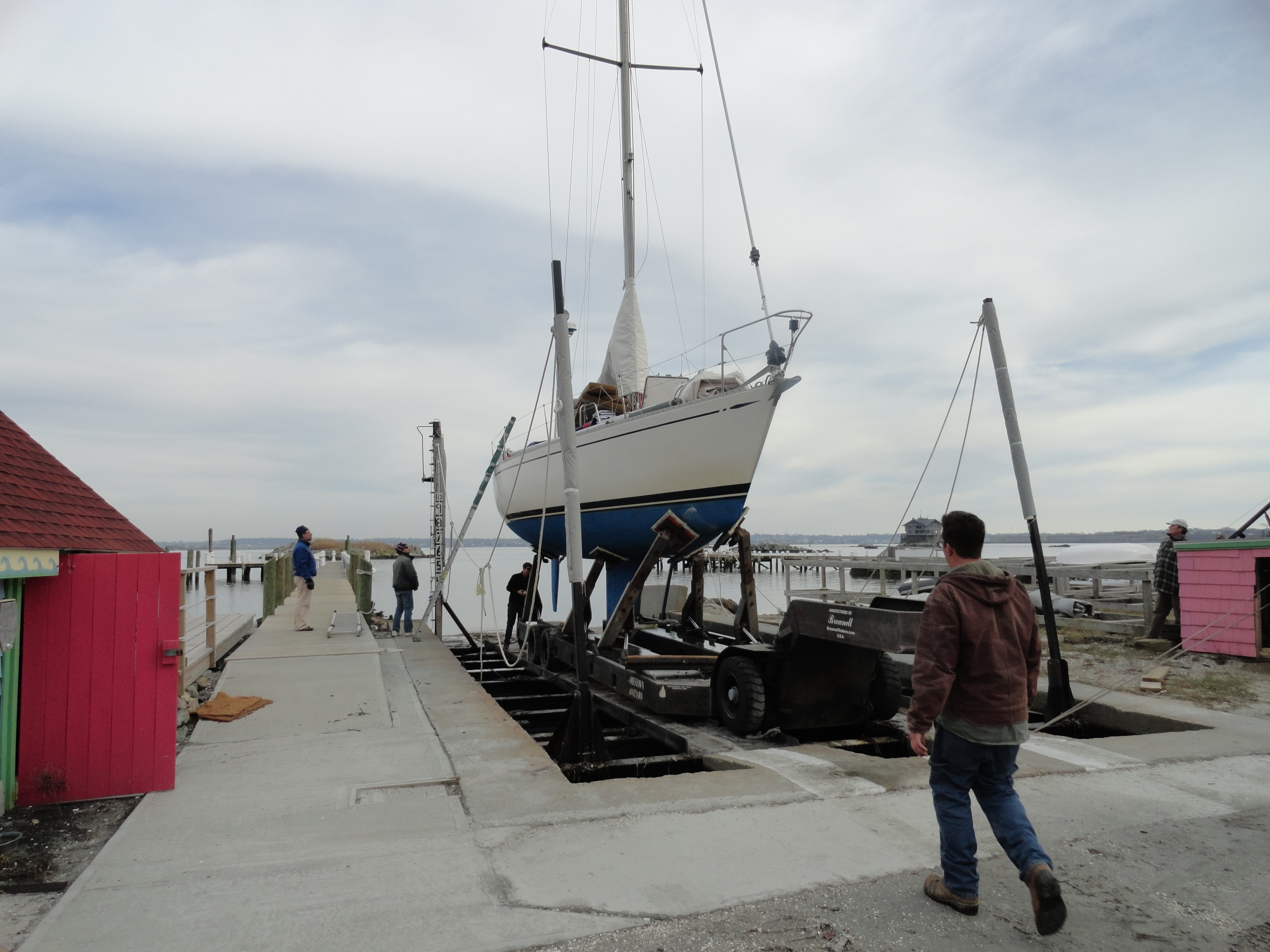
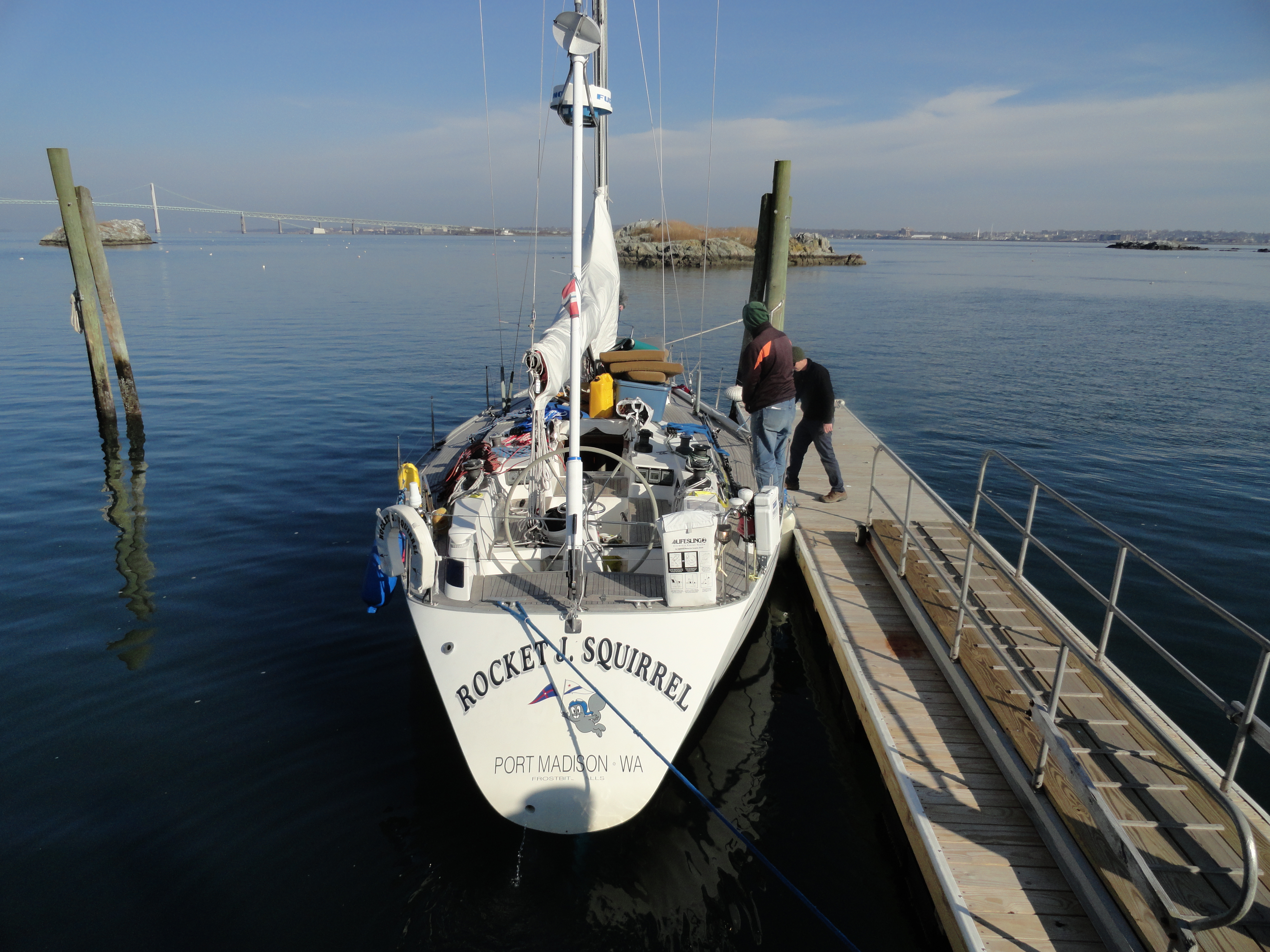
Our crew went to work cleaning out the boat by getting the bunk cushions, bed rolls, blankets, life jackets, and other items onto the dock to dry out and freshen up in the warm sun. Temperature by then was in the 50’s. All cabinets were cleaned out and old items were put in trash bags. Dan, the designated cook and galley maiden, began making a shopping list for grocery provisioning. Mark was making a list of tasks that needed done before we departed such as clean and lube the hatch gaskets, stow the sails needed by the Owner in St. Maarten, etc. Thursday evening lighting on that boat was inspected. Several bulbs in the salon and stateroom, galley, and head were out and needed to be replaced. The running lights were all working except the anchor light power seemed to be tied to the breaker controlling the VHF radio. It was also determined the wiring of the chartplotter, instruments, and autopilot were connected to two separate breakers. Mark added these items to the list of incomplete work for the boat yard crews on Friday. Mark and Dan went to the grocery store for provisions, West Marine for light bulbs and other supplies, and by the Owner house to pick up the Sat phone. Mark, later that evening, determined the simm card was bad in the Sat phone and one was shipped overnight for Saturday AM delivery. The crew delayed the departure until Saturday AM. By noon on Saturday, UPS had not arrived and Mark confirmed that UPS does not make Saturday deliveries to Jamestown. Mark made the decision to depart without a working Sat phone.
At approximated 3 PM, on Saturday, December 7th, the motor started, dock lines were thrown, and “the Squirrel” pulled away from the dock at Jamestown Boat Yard for her first leg of the voyage to Bermuda, a distance of about 635 nautical miles, and then on to St. Maartin. Donald brought his computer loaded with a software package, Maxsea Times Zero. Maxsea includes weather forecasting and sail routing modules. Earlier, Donald had downloaded weather forecast for the North Atlantic from Rhode Island to Bermuda. The forecast called for moderate NW winds through Sunday with the winds shifting to the NE Sunday evening through Monday AM. The wind on Monday was to shift to the E and then quickly to the SW Monday night. Wind velocity was forecast to increase to 20-25 knots into Tuesday morning. Seas were to increase to 10-12 ft. at 6 second intervals with wind waves of 2-4 ft.
Mark decided the sail plan called for a departing heading of 190-200 degrees for the first 24-36 hours. The DR heading to Bermuda is 160 degrees. It is not wise to try to cross the Gulf Stream with winds out of the NW, N, or NE. The SW winds were preferable. At the 6 PM Sunday watch change, Mark decided to jibbed the sails and change to a course of 160 degrees and head for Bermuda. At the midnight watch change, the wind had not shifted to the SW and the decision was made to heave to until the shift occurred. Finally, around daybreak on Monday morning the wind shifted to the SE. The sails were powered up and we headed across the Gulf Stream. The waves remained mixed and confused, but by noon on Monday Mark declared we were through the stream with water temperatures in the low 80’s, a good sign. It was overcast and began to rain. Dan called out with a whistle from the cockpit that the autopilot was not holding course. Mark and Donald went below to check to see if the autopilot motor was working. Mark saw that the arm connecting the motor and the rudder had come loose and fallen off. It appeared the boat yard had not tightened the set screw holding the sleeve onto the arm. Mark found the sleeve, key, and attempted to reconnect the arm. He was successful, but several hours later it came loose again and it was decided we would have to hand steer until we got to Bermuda and could get the proper tools to fix the autopilot.
Around 9:30 AM, on Tuesday, John was on watch. Mark, Dan, and Donald were having breakfast in the salon when the boat felt out of control. Mark went to check on John who reported that he did not seem to have control of the steering. Mark took over and declared we had lost the rudder. Seas at the time were 10-12 ft. with the wind 18-20 knots, gusting to 25 knots. Not knowing the extent of the damage, Donald began preparations to abandon ship. Dan immediately started to inspect the bilge and the rudder post for function and leaks. Dan determined the rudder post was intact and all cables appeared to be tight and working properly. During the next hour, Mark determined we had some steerage on had probably lost only a portion of the rudder. Without full rudder control we were not able to maintain a straight course to Bermuda. We were definitely at the mercy of wind and waves. We were approximately 300 kms. NE of Bermuda.
Due to the conditions, we were constantly taking water over the deck and waves were breaking over the side of the boat. Several times waves broke over the side and filled the cockpit causing water to come over the top of my boots. We had been running the engine about every 10-12 hours to charge the house batteries. Tuesday night, while running the engine, the engine alarm signaled a problem with the fuel. Mark and Donald began investigating and found water in the Racor water separator. This required draining the water from the separator bowl and filling the top fuel reservoir with new diesel. The seas and boat action made this very difficult, but it was accomplished. Over the next three days we emptied over a quart of water from the system.
Donald knew from studying the Maxsea weather forecast that we would have a major wind shift from the SE to the N and then NE during the early morning of Wednesday. Mark estimated it would hit us around 9 AM on Wednesday. Donald thought it would happen sometime after midnight on Tuesday. Around 12:30 Wednesday morning the wind shift happened with driving rain. 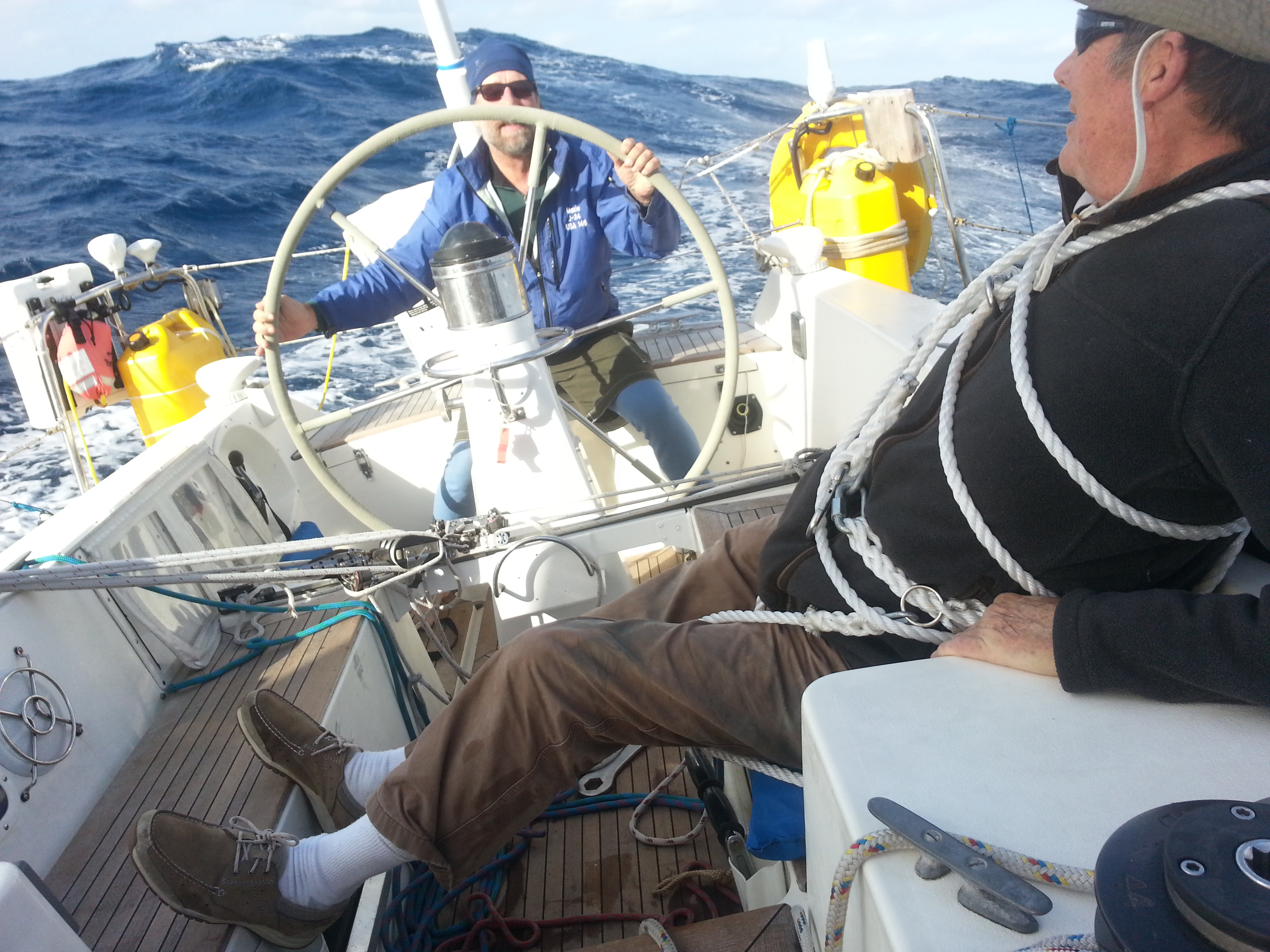 Mark decided that he and Dan would stand watch until daybreak and then reassess our status. At daybreak, the winds decreased to 15-18 knots. The rain slacked to a light drizzle. Donald made coffee for Dan and John and sausage, egg, and cheese English muffins for the crew.
Mark decided that he and Dan would stand watch until daybreak and then reassess our status. At daybreak, the winds decreased to 15-18 knots. The rain slacked to a light drizzle. Donald made coffee for Dan and John and sausage, egg, and cheese English muffins for the crew.
The N to NE wind allowed the crew to steer the boat on a relative DR course to Bermuda. By Wednesday AM we were approximately 150 kms. from Bermuda. We maintained a course of 150-180 degrees through Wednesday. Dan gauged the fuel tank and determined we had enough fuel to motor to Bermuda. After motoring through the night, the lights of Bermuda were seen off the starboard bow. The wind decreased to a calm, the seas continued to subside, but the light rain continued.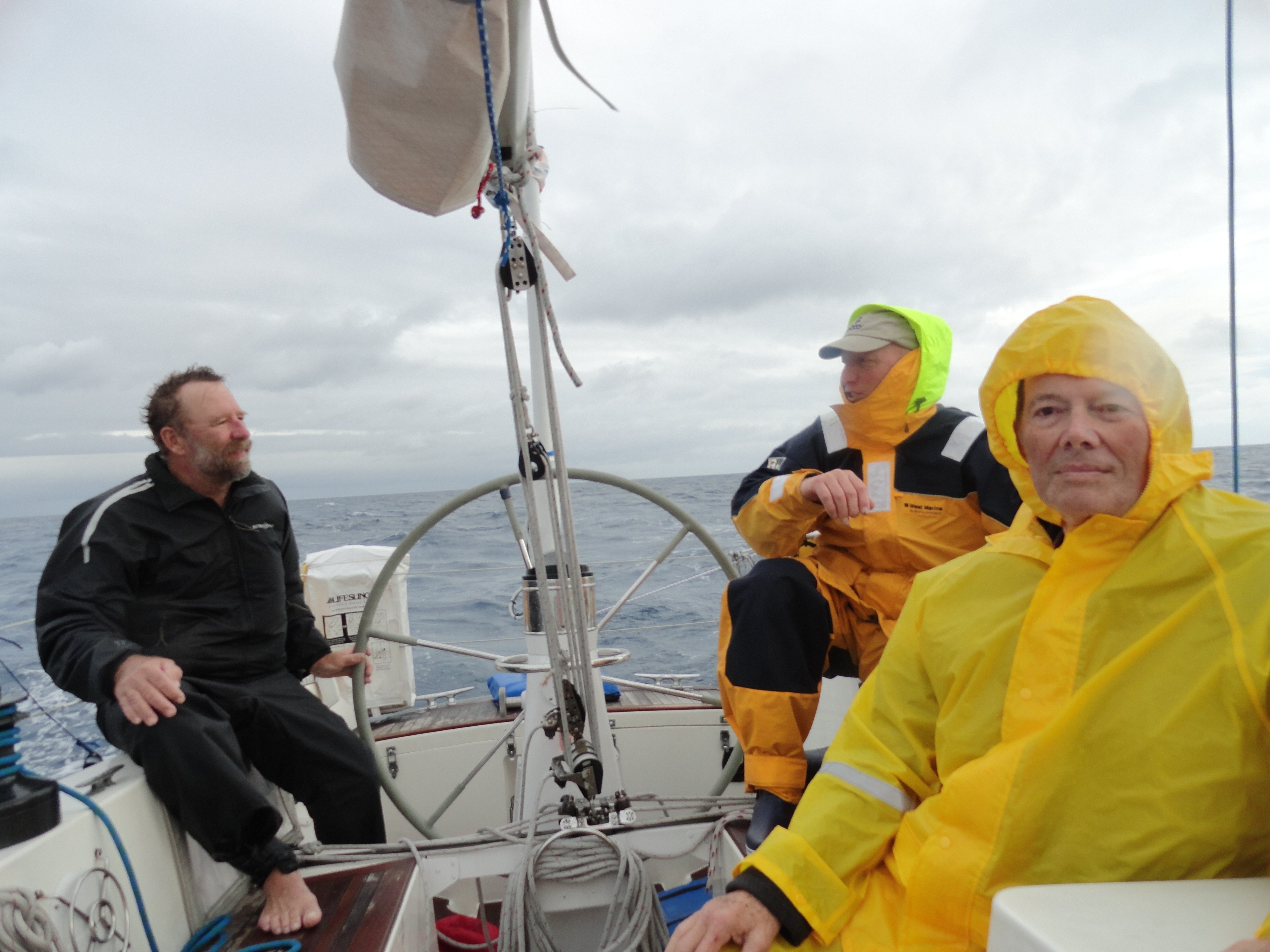 At approximately 8:30 AM on Thursday, we passed the Mills Buoy marking the outer entrance to Town Cut channel opening in the rocky shoreline of the east end of Bermuda.
At approximately 8:30 AM on Thursday, we passed the Mills Buoy marking the outer entrance to Town Cut channel opening in the rocky shoreline of the east end of Bermuda. 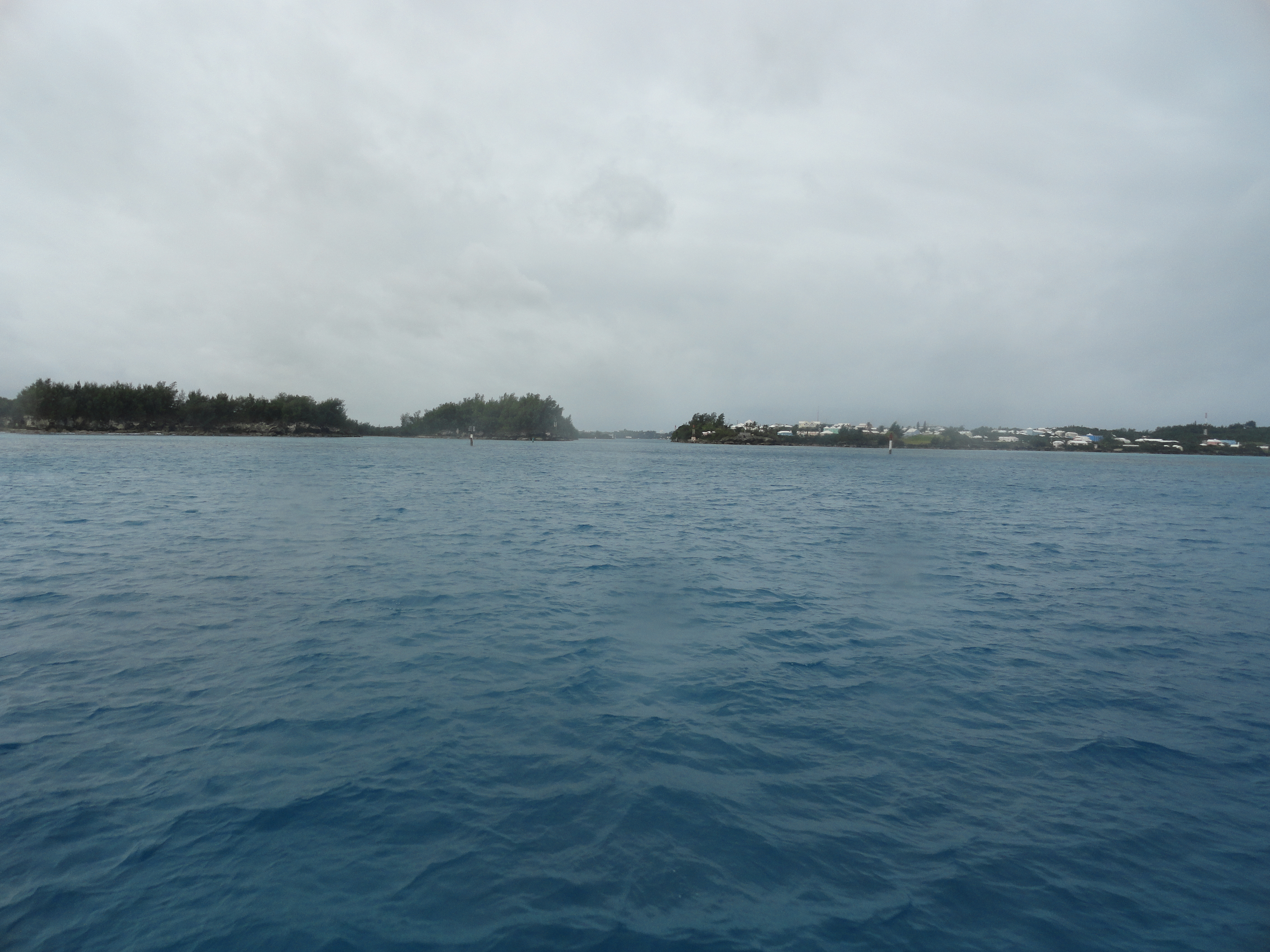 After clearing Town Cut we doused the sails and prepared to dock at the Bermuda Customs office at St. Georges, Bermuda.
After clearing Town Cut we doused the sails and prepared to dock at the Bermuda Customs office at St. Georges, Bermuda.
We were the only boat at the Customs dock and cleared Bermuda Custom in about 20 minutes. The bulkhead across from the Customs office was clear. Mark chose to tie up near steps in the bulkhead making boarding easier for all of us.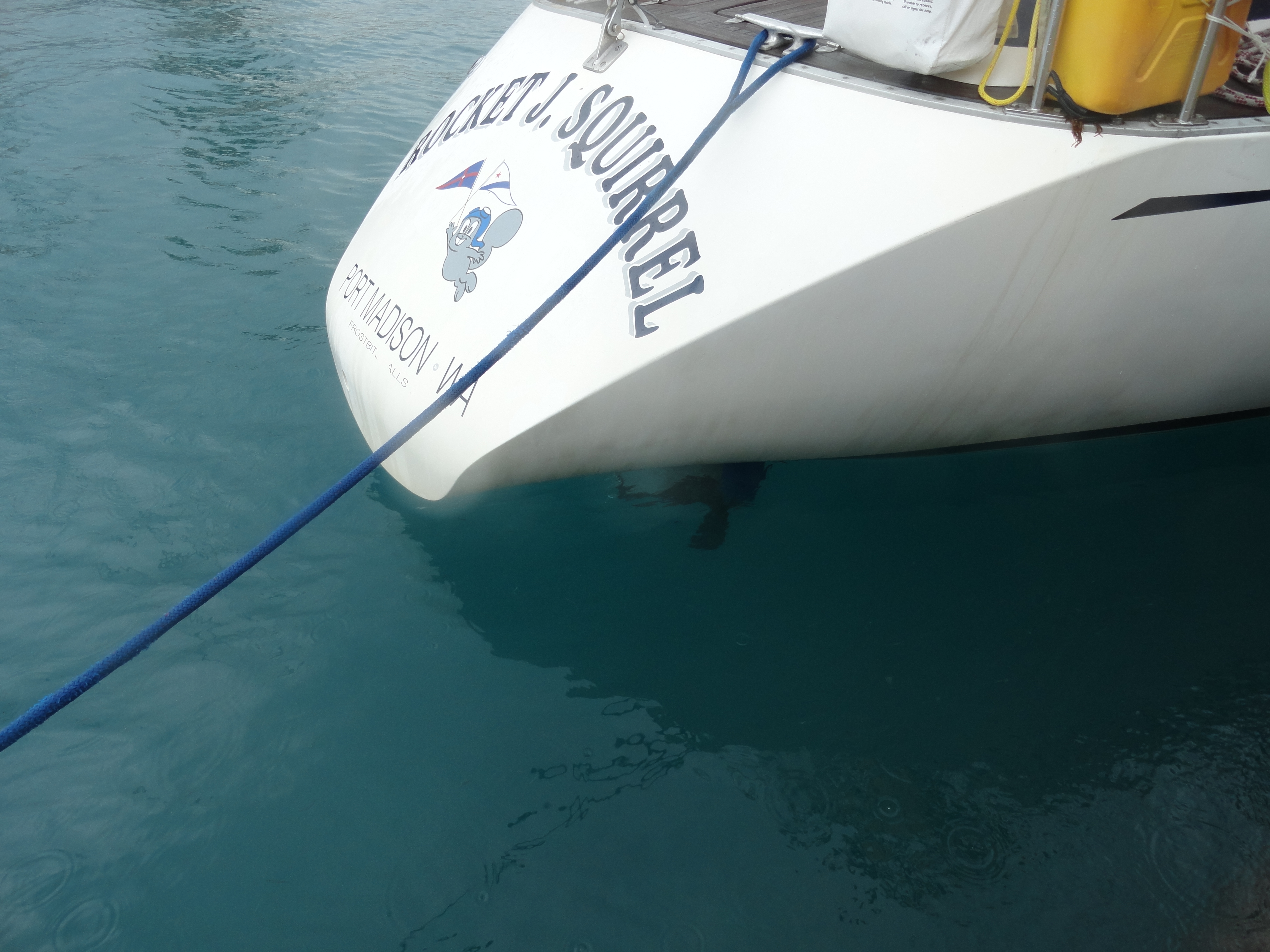 We found JoJo’s and got some hot clam chowder, crackers, and hot tea before heading to the boat for a shower and dry clothes. Donald headed to the White Horse Bar and Grill to see if internet connections were available. The White Horse has free internet and Donald was soon searching Orbitz for plane reservations back to Houston. The other three joined him and used the computer to catch up on emails and to let everyone know our status. The crew decided to have dinner at the Wahoo Restaurant, a St. George’s favorite. Their specialty is BBQ’d Rock Fish Ribs with rice and peas and cold slaw. Tasted great.
We found JoJo’s and got some hot clam chowder, crackers, and hot tea before heading to the boat for a shower and dry clothes. Donald headed to the White Horse Bar and Grill to see if internet connections were available. The White Horse has free internet and Donald was soon searching Orbitz for plane reservations back to Houston. The other three joined him and used the computer to catch up on emails and to let everyone know our status. The crew decided to have dinner at the Wahoo Restaurant, a St. George’s favorite. Their specialty is BBQ’d Rock Fish Ribs with rice and peas and cold slaw. Tasted great.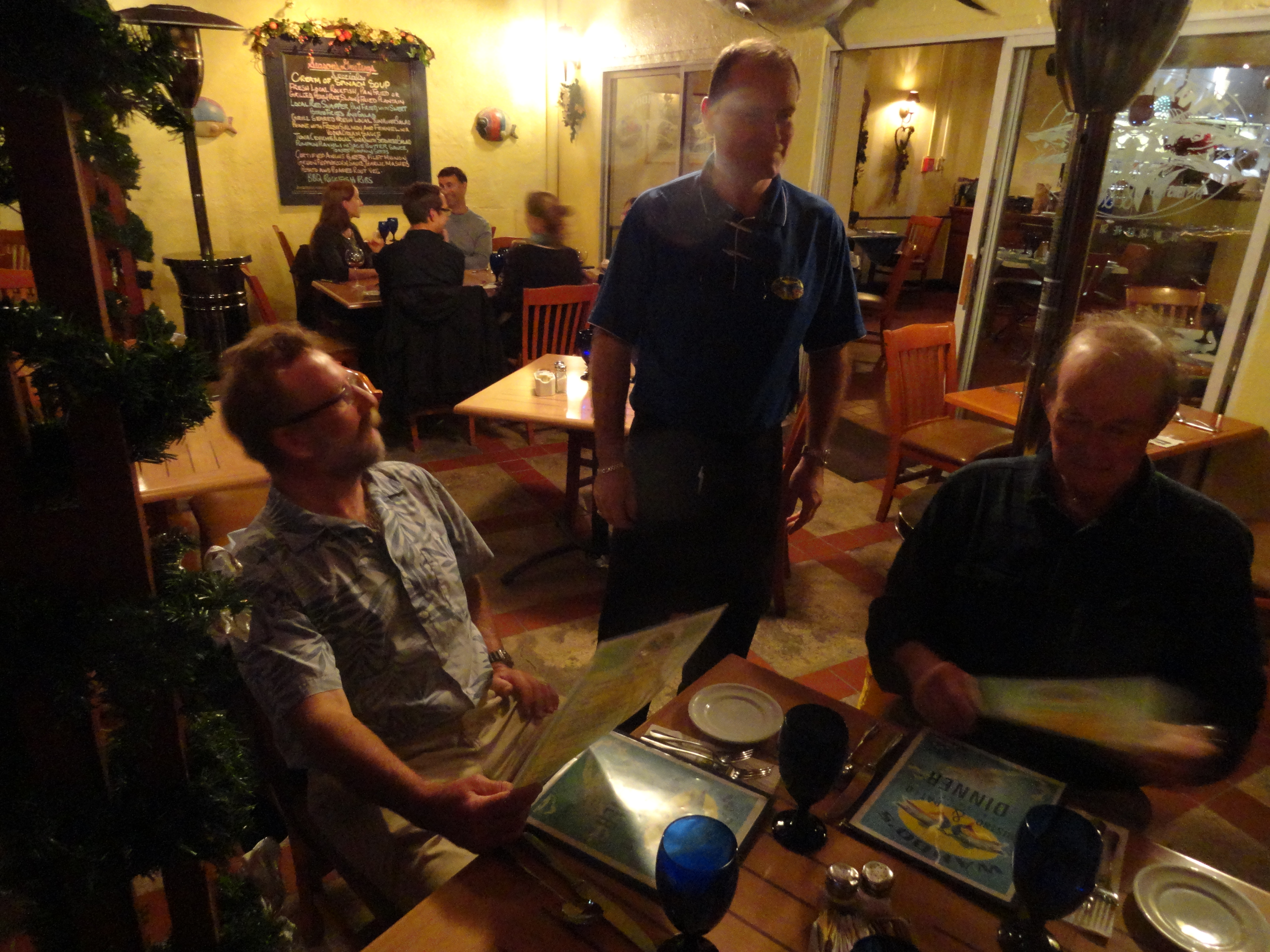
John made reservations to fly out on Friday around 2 PM, so he left for the airport around noon. Mark made final arrangements through “Moma” at Bermuda Yacht Services to have the boat hauled at the Boat Yard located on the west end of the island. Donald made airline reservations for early Saturday AM and hotel reservations at the Grotto Inn and Resort near the airport for Friday night. Dan and Mark decided to move the boat to the Boat Yard around 3:00 PM. Donald cast the lines from the dock and watched as the “Squirrel” backed away from the dock and turned to head back out Town Cut and around the north side of Bermuda to where she will probably spend the next two months waiting on a new rudder. Picture of rudder out of the water.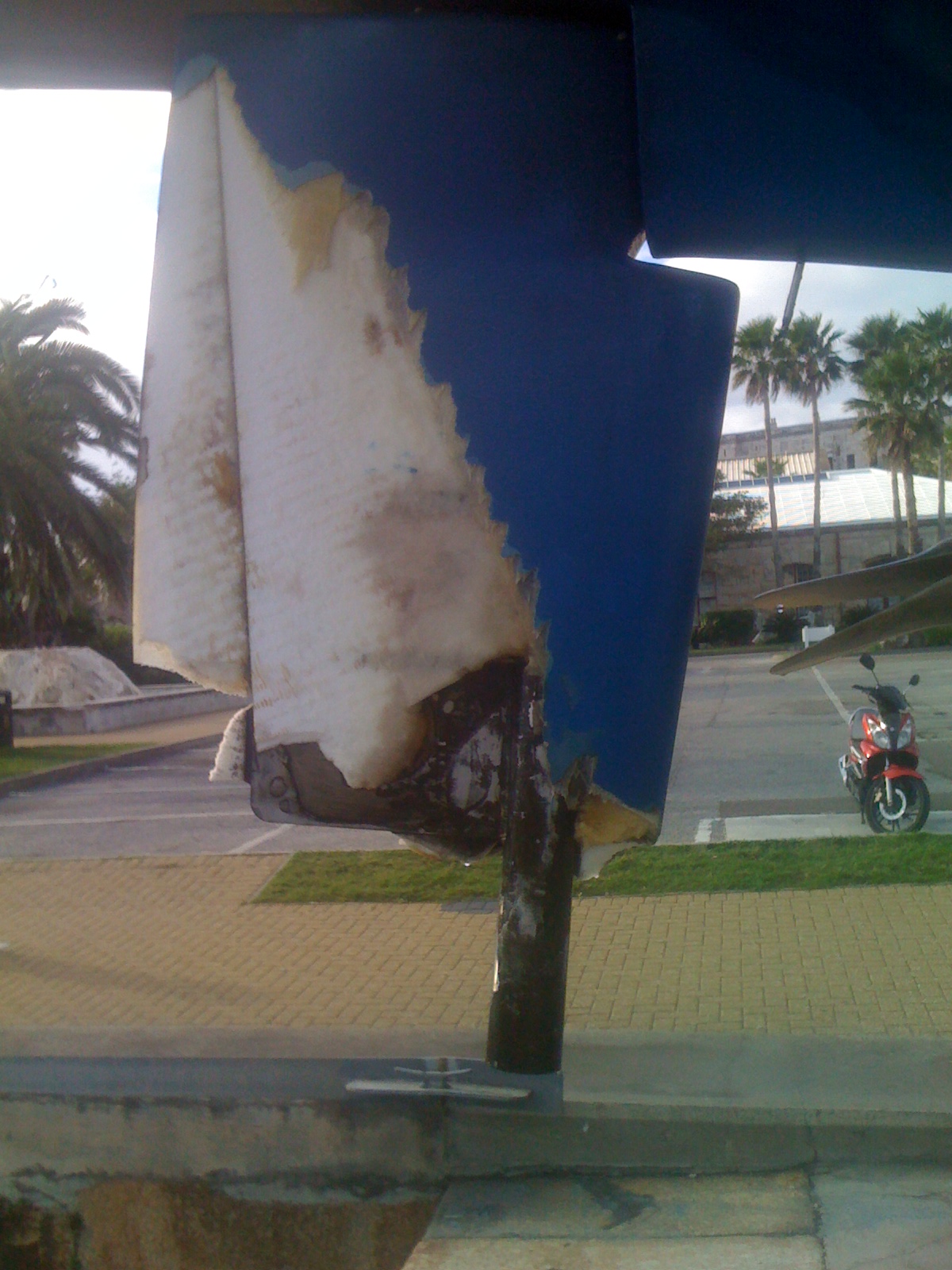
The “Squirrel’s” open cockpit, leaking deak, lack of boat yard preparation for the trip, and general operating conditions made me really appreciate the comforts of SV Ruthless.
